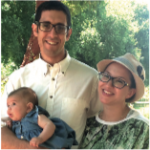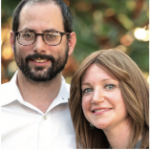Around the Shabbat Table
How do we keep our Shabbat tables lively, engaging, and a centerpiece of the week? How do we—whether married, single, frum-from-birth or ba’al teshuvah—ensure that our Shabbat table is fun, relaxing and spiritually rejuvenating all at the same time? We asked a diverse group of individuals to share their thoughts. You’ll note that some of the same themes come up over and over again, which means one thing: it’s probably a good idea—try it yourself!
Editor’s Note: Certain halachic issues arise when inviting non-observant guests for a Shabbat meal. Please make sure to consult with your own rabbi.
 Sarah Boczko
Sarah Boczko
Woodmere, New York
As told to Dovid Bashevkin
It’s hard having conversations with all of your children at a Shabbos table. They’re all different ages and each one just wants to do his own thing. Early on I found myself trying to have a conversation with my husband while each child was grumbling about what went wrong during the week. So we decided to try something different. At the beginning of our Friday night meal we go around the table and ask each individual to share one thing that made him or her happy over the course of the week. Everyone—including our guests—participates. It starts Shabbos off with some refreshing positivity. We don’t accept “being here for Shabbos” as an answer—that’s a cop-out. We’re often surprised by how sweet and sincere many of the answers are. It consistently makes our Shabbos table a happier place.
Sarah Boczko, a board member of Shalom Task Force, lives in Woodmere, New York, with her husband and their four children.
Ramat Beit Shemesh, Israel
As told to Dovid Bashevkin
School is not the center of our Shabbos table; family is. So we don’t really have a lot of parashah sheets, quizzes or posters. Unless a child wants to share, we try to keep school pressures and responsibilities away from the Shabbos table. I don’t ask anyone to share divrei Torah. The meal needs to be organic and natural. I’m much more interested in a funny joke or good shtick than a nervously rehearsed devar Torah.
Dips are also really important. A good dip selection is a great way to bring people together. And nothing sours a meal like poorly apportioned soup. Plentiful dips and liberal soup distribution seem to be a good recipe for cultivating a hospitable Shabbos table atmosphere.
Reb Judah Mischel is mashpia of National and New York NCSY, and the executive director of Camp HASC, the Hebrew Academy for Special Children.
Woodmere, New York
As told to Dovid Bashevkin
The Shabbos table needs to be something that everyone looks forward to. It needs to be joyous. Singing zemiros is a great way to cultivate a sense of joy at your table. The melodies and the words can uplift and inspire. Full disclosure: I happen to be very musical. But my father wasn’t, and it didn’t stop him from singing with his whole heart. When kids are growing up, they don’t always appreciate zemiros; kids ages four to twelve often find the singing tedious. But when the kids get older, the routine starts to pay dividends. The songs become instinctive and the singing allows them to access a sense of joy that otherwise can be hard to teach if you didn’t grow up with it. Conversations interest some, but not everyone. Zemiros can make it easier for everyone to participate. That’s why my wife and I sit on opposite ends of the table—it makes it easier for everyone to feel connected. I share Torah, but I don’t force others to. Kedushah can’t be forced. The meal should be spiritually tantalizing so that everyone walks away wanting more.
Rabbi Yisroel Kaminetsky is rosh yeshivah and menahel of HALB’s DRS Yeshiva High School for Boys in Woodmere, New York.
Yael, fifties
Brooklyn, New York
After many years of being invited to other people’s Shabbos tables, I decided I wanted to do Shabbos my way. So I started inviting guests to my own Shabbos table. I found that Shabbos was so much more meaningful when I shopped and prepared for it on my own. I actually enjoyed all the hard work! I loved the idea that rather than being a guest at someone else’s table I was the one determining how many divrei Torah to share and zemiros to sing.
Lawrence, New York
As told to Dovid Bashevkin
In our home, the primary goal of the Shabbos table was to engage our children, at whatever age they were. I wanted it to be the most memorable part of their week. My wife and I believe that parents are their children’s principal educators, and we found the Shabbos table to be the ultimate classroom. It is the place to convey values and knowledge, and is the ideal place to imbue a sense of excitement and love of Yiddishkeit. After all, it is at the Shabbos table where Shabbos can be transformed from being restrictive and burdensome to being thrilling, and perhaps even the centerpiece of the week.
You know you have failed if children need to be told to stay at the Shabbos table. The goal is to create an experience they would never want to miss! It must be entertaining, unpredictable and full of joy. The challenge for parents, of course, is how to make that happen. I confess that on a regular basis I would spend two to three hours between Thursday night and Friday afternoon planning the event, constructing the topics to be explored, the debates to be triggered and the lessons to be taught. We explored Jewish beliefs, the pros and cons of alternative political systems, Torah leaders, the proper roles of loyalty, friendship and duty, and more.
I also discovered that the Shabbos table was the perfect solution to one of the most perplexing challenges of parenting. Early on I had noticed that whenever a child, at any age, is scolded or rebuked by a parent, a distance is imposed. And this distancing is not a good thing. I also recognized that children in emotionally healthy homes generally love, if not worship, their parents and hang on to their every word, with one caveat; like adults, children abhor being told what to do. The challenge for parents is therefore how to correct children’s misbehavior or imperfect personality traits without confronting an inevitable wall of resistance, and without imposing the distancing. The solution is Shabbos guests.
Most weeks we would host guests of varying ages and backgrounds, but hopefully with an interest in ideas and debate. Just about when everyone was being lulled into the familiar serenity of enjoying the Shabbos meal delicacies, guests would suddenly be confronted with intense questioning, thorny challenges or provocative theories. Heated debates ensued, often emotional and always enthralling. Most importantly, the discussions were typically embedded with lessons that my children would more likely accept because they were not being lectured at. In fact, the kids would usually not even notice that the themes, such as sharing, caring and personal discipline, were deliberately introduced for their ears.
Well, the years have passed and the children have children of their own, and Shabbos table styles to construct and master. We still enjoy Shabbos guests and still relish the exploration of ideas and debate. But the urgency to entertain or to imperceptibly rebuke is now our children’s concern. We can pay more attention to the delicacies.
Moishe Bane is president of the OU and a senior partner and chairman of the Business Restructuring Department at the international law firm, Ropes & Gray LLP.
Zev, early thirties
Washington Heights, New York
The most important ingredient in hosting a dignified Shabbos meal is, without question, sensitivity to one’s guests. Whether there is a large or small crowd, there are usually introductions, and this can be a potential minefield. Is the guest new to town and, if so, why did she or he move? Is she or he presently in career transition, such that the simple question of “Where do you work?” might engender embarrassment? Seasoned hosts know to think ahead about how or if they should ask certain questions.
Woodmere, New York
Our Shabbos table was—and, when kids are present, still is—decidedly child-centered. Several illustrations come to mind. During the main course or dessert, we would announce, “Drumroll, please! It’s time for . . . H.O.W.” If some guests looked puzzled, our children would enlighten them: It’s time to share a highlight of the week. But we always mentioned that it was okay if someone needed to share a lowlight of the week.
I tried to tailor Shabbos menus to the Torah portion. For example, Parashas Noach was Rainbow Shabbos, featuring foods like corn salad, carrot kugel, cranberry relish, orange chicken, blueberry cake and grapes. I often served lentil soup on the Shabbos we read Parashas Toldos.
No matter how tough someone’s week may have been, there’s always something to appreciate.
We made zemiros participatory. Before they were old enough to know the words, our children chimed in with “Toot! Toot!” during Yom Zeh Mechubad. My husband often swung them around in time to a zemer’s cadence. If another man was present, he would join my husband away from the table. Facing each other, they would hold hands and sway while our children took turns running between them, determined to get to the other side. The men would “attempt” to catch them, usually “unsuccessfully.” But every now and then, a child would get caught by four loving arms.
As our children got older, starting at around age ten, we encouraged them to add their own homemade challah rolls, side dishes and desserts to our Shabbos menus. And of course, they always received full credit and sincere praise for their culinary contributions.
Chava Willig Levy is an award-winning lecturer, editor, advocate and author with a particular interest in childhood, parenthood, Judaism, disability and family life. Her memoir, A Life Not with Standing, was published in 2013.
Joey, thirty-two
Miami Beach, Florida
I prefer to eat a Shabbos meal with families rather than with singles. Even if the kids are grown and gone, there’s something homey about being at a married couple’s Shabbos table. I enjoy watching the interaction between husband and wife. I think that I am probably subconsciously taking notes and filing them away for when I have a wife and kids.
Of course, I am grateful to every family that hosts me. But I wish families would say no if they are not up to hosting. I get that the parents may have had a long work week and kids act out or just want their parents to themselves. Just tell me. There’s nothing worse than sitting at a table where it’s clear other stuff is going on and it would be better if it were family only.
Denver, Colorado
Is this a tautology? The Shabbos table is for . . . Shabbos. Not for testing how well the children learned the parashah, not for tasting sumptuous foods, not for singing zemiros, not for hosting friends or family, not for dressing up in Shabbos finery, not even for rest. Wait a minute! Isn’t all this just what a Shabbos table is all about? Actually, no. I can test my child on Sunday, sing on Monday, eat delicacies on Tuesday, spend time with friends on Wednesday and with family on Thursday, and dress up or take a nap on Friday. None of these acts define a Shabbos table unless it is for . . . Shabbos. The whole is greater than the sum of its parts.
Shabbos is greater than the activities which, yes, can and should define the Shabbos table, but do not always do so. If one’s Shabbos table is saturated with Shabbos, then even if a child stumbles on the parashah, even if a course is missing, or guests are not present, or the singing is off, or if I forgot to pick up my suit from the cleaners, it makes no difference because I have . . . Shabbos. When Shabbos is lived; when Shabbos is felt; when Shabbos is a different spiritual universe; when my relationship with Hashem ascends to a qualitatively different plane, then I have a Shabbos table! It’s automatic. Everything at the table is holy. Shabbos comes first and Shabbos is priority. That is the key.
Put it this way: Am I cooking up a storm because that is what I am supposed to do for Shabbos? Or am I cooking up a storm because I feel Shabbos coming and can’t wait to taste it, not only physically but spiritually? Am I reviewing the parashah with my children because they need to know it, or because the Torah reinforces Shabbos and Shabbos reinforces the Torah? Am I singing because that is what we are supposed to do on Shabbos, or in order to connect with the Giver of Shabbos? Am I resting because I am tired, or because Shabbos sleep is totally different from weekday sleep? Inner religious feeling and conviction create the Shabbos table.
Obviously, I do not mean to diminish all the gestures that give Shabbos its character, but to say—do not lose sight of the end for the means. If the children around the table are to relish Shabbos twenty years from now, the key is this tautology: Shabbos is for . . . Shabbos.
Which means that if one is an empty nester and the natural number of souls around the table drops, perhaps even to no one but me and my wife, it makes no difference. Because my Shabbos table is for . . . Shabbos.
Rabbi Goldberg is the author of Countdown to Shabbos: Bringing the Week into Shabbos, Bringing Shabbos into the Week (New York, 2018). He is also the editor and publisher of the Intermountain Jewish News, and a contributing editor to Jewish Action.
The Outreach Shabbat Table
Brighton Beach, Brooklyn, New York
As told to Steve Lipman
My wife, Gabriella, and I regularly invite people from the Russian-speaking Jewish community for meals at our home, usually on Friday night. Since I am from Odessa, I understand the Russian mentality. Even though not all of our guests are religious, they are respectful. Secular Russian Jews, more so than secular American Jews, are comfortable with the Orthodox experience. And they are more comfortable accepting a Shabbat invitation.
We don’t have official guidelines about behavior or dress. I remember a Shabbat meal I went to years ago before I became religious, in a heavily Orthodox neighborhood. I was bored. I went into another room and started playing a game on my BlackBerry. I didn’t know any better. My hosts didn’t say anything.
In a small Jewish community it is easy to meet people. We enjoy meeting and socializing with people from all walks of life.
With Russian-speaking Jews, our Shabbat meals are long and loud—with many interruptions. People stay and schmooze, even if Shabbat comes in early, until midnight or 1:00 am. Our house is rowdy and we joke around. The Russians love it.
Since the meals are long, we don’t put out all the food at once. A little at a time. Lots of soups and salads. Different kinds of fish. Lots of different potatoes.
Instead of a formal devar Torah, I encourage my guests to think for themselves. I pass out photocopies with thoughts about the parashah, and have the guests explain what it means. We don’t do too much singing—most of the people don’t know the tunes.
After the meal, everyone helps clean up. We then serve dried salty fish, Russian beer and sunflower seeds. And it’s essential that we have different kinds of teas. Lots of tea.
Simcha Asnes, who works in the construction business, is active with his wife, Gabriella, in the Russian American Jewish Experience (RAJE), an outreach organization in Brooklyn.
 Rabbi Joe Wolfson and Corinne Shmuel
Rabbi Joe Wolfson and Corinne Shmuel
New York University campus, Manhattan
As told to Steve Lipman
On Friday night, in a big hall on the NYU campus, we have between 120 and 180 guests, sometimes more. We primarily serve the school’s Modern Orthodox community, but our guests come from across the Jewish spectrum.
My wife Corinne and I arrive first, so we can greet every student as he or she arrives. Around twelve tables are set up. We encourage students to sit with people they don’t know.
I try to circulate during the meal. I’d rather have a short conversation with fifty students than an intense one with two or three.
The room is too big for everyone to sing a zemer at the same time. I’ll invite the students who wish to sing—usually about forty—to come to our table.
Our Shabbat day meal is more personal. It is held in our apartment and is a smaller affair, usually between eight and twelve guests. Corinne was trained in Israel as a professional chef, but we share the cooking.
I lead the meal, but try not to dominate it. As an ice-breaker, we always ask a thought-provoking question. On Presidents’ Day weekend last year, Corinne asked, “If you were the president of the United States, what is the first piece of legislation you would enact?”
For a college student, a Shabbat meal plays a different role than for those in the larger Jewish community. For students, it’s a break from the maelstrom of the week, a time to socialize, a place where they can throw themselves down on a couch.
Shidduchim? We don’t do it formally, but on occasion we might point people in a certain direction. A few years ago, we met a young woman, a freshman, who had roots in Russia. We told her to come to our Friday night post-meal oneg at our apartment; about sixty people were there. It seemed to be a big mistake—she was extremely shy; she looked like she was suffering. But she came back the next Friday night. And she came to some of our Shabbat day meals. By the end of the semester she was a completely different person. Within a few weeks she had a boyfriend. And a few months ago, she became engaged to the boy whom she had met at that Friday night oneg.
Rabbi Joe Wolfson and his wife Corinne Shmuel serve as OU-JLIC Torah educators at New York University.
Jerusalem, Israel
As told to Steve Lipman
I have been inviting guests to my home for Friday night meals since I moved to the Old City thirty years ago.
Organizations that send people to homes for Shabbat meals usually prefer families with children, not single people. Especially not single women. But there is no reason that a single person—and a single woman such as myself—cannot host Shabbat meals. I’ve had couples, yeshivah students, Christians, Muslims, atheists, visitors from China, and people of various races come to my Shabbat table.
My meals are part fun, part serious. There’s always a devar Torah and some singing.
The host should not dominate the meal. I like to ask an interesting question that shows something about each guest. It can be an idea from the parashah, an upcoming holiday, or anything intriguing like, “What is an interesting act of kindness you have experienced?” and step back.
A devar Torah has to be relevant to people’s lives. It can’t be too long, no more than three to five minutes. I will print out one of Rabbi Jonathan Sacks’ divrei Torah on the parashah, paraphrase it, shorten it and underline the parts I find interesting.
I let people talk about what they want to talk about—politics, movies, et cetera—at the table. I don’t like to spend too much time between courses. Dessert is the time to linger and relax.
A social worker originally from Pittsburgh, Tova Saul is a tour guide (israeladventures.yolasite.com) and animal rescuer (israeladventures.yolasite.com) in Jerusalem.
Hollywood, Florida
As told to Leah Lightman
My wife and I met and married during our respective journeys becoming frum. We had participated in many Shabbos tables during those individual journeys and wanted to give back.
My family has titled our Shabbos table the “Friday Night Experience” to reflect that it is more than just coming together for a meal. It’s about caring and connecting with one another and with our Judaism.
Over the years, our Shabbos table has been filled with growing friendships, singing and loads of explanations and Torah talks. One highlight of our Friday night experience is my famous chicken soup. During that course, each person at the table talks about something he or she has appreciated during that week. We call it the “highlight of the week.” No matter how tough someone’s week may have been, there’s always something to appreciate.
Because I teach on a volunteer basis for Aish HaTorah, which was instrumental in my becoming religious, many of our guests come from the local Aish HaTorah. We explain each step and answer questions. It’s a lively table; our frum-from-birth friends have told us that they’ve never experienced anything like our heartfelt zemiros. Some have said that even though they’ve grown up frum, they are often learning for the first time at our table why we do certain mitzvos and customs.
Our children are the most important part of our Friday night experience. They sit next to my wife and me and the guests fill in the rest of the table (which seats twenty comfortably). Our children are never displaced, and they have grown up experiencing and appreciating how to be machnis orchim.
A founding member of the prominent Miami law firm Peretz, Chesal & Herrmann, PL, where he specializes in intellectual property law, Michael is chairman of Aish South Florida. He taught a weekly course on Jewish ethics at Aish for over five years and continues to give regular classes there on a variety of subjects.
Norfolk, Virginia
As told to Steve Lipman
In the years we have lived here, we have hosted guests nearly every Shabbos. Currently, we aim for between five and eight guests, both men and women, per meal. We try to get to know every guest personally and keep our children involved.
Our guests come from the wider Norfolk Jewish community (population, about 10,000), and from the nearby Norfolk Naval Station, the largest Navy base in the world (about 100 Jews are stationed there at any time). Our guests also include visitors, tourists, and members of our congregation (about ninety families).
In a small Jewish community it is easy to meet people. We enjoy meeting and socializing with people from all walks of life.
Most of our guests are individuals with whom we have a relationship outside of the Shabbos meal. We don’t simply go up to people we meet and introduce ourselves and invite them to a meal. We find that people feel more comfortable accepting an invitation when it’s part of a larger, meaningful relationship.
The culinary spread spans continents, always with new delicacies. While many women have one tried-and-true challah recipe, I enjoy trying different ones. The aromas wafting through our home make quite the perfume, a boutique fragrance unique to us.
Many of our guests are not shomer Shabbos. (Some drive to us but they always know that they are invited to stay for the entire Shabbos.) We learned this principle of tolerance growing up in rabbinical homes “out of town.” One example: When I [Sender] was a child in Buffalo, my father, Rabbi Yaacov Haber, once invited a man, about eighty years old, who had recently come from the former Soviet Union. The man was a violinist; he arrived at our house before the meal, carrying his violin in a case.
When my father came home from shul, the man took the violin out of his case and began serenading my father with his violin—he played Hevenu Shalom Aleichem. He didn’t know you’re not supposed to play musical instruments on Shabbos; it was his way of giving thanks.
My father didn’t react. Instead, after the performance ended, he told the man that it was better not to play the violin on Shabbos. The man was not insulted; he came back the next week, without the violin. My father acted the same way when guests did other things at our table that are forbidden on Shabbos, like writing.
We strive to accept our guests as they are. Inevitably they will leave with a greater understanding and appreciation of how we observe and cherish Shabbos.
Our five children love having guests on Shabbos. We try not to control the pace of the meal, not to make it too structured, not to stop abruptly for a devar Torah or a zemer. But by the end of the meal there is a devar Torah and some singing.
It’s a meal, not a class. We see our meals as a chance to practice our love of all Jews; we don’t have an agenda.
Sender and Chamie Haber are, respectively, rabbi and rebbetzin of B’nai Israel Congregation in Norfolk, Virginia.
The Ever-Evolving Shabbat Table
By Rosa Layman*
Newly married, we were two ba’alei teshuvah establishing a Torah home. Neither one of us came from a frum home, yet we have developed our own “Shabbat table mesorah” that is meaningful, enjoyable and spiritually uplifting.
Before we met and married, my husband and I were each privileged to be embraced by families that opened their homes and their hearts, welcoming and hosting us at their Shabbat tables. These memorable years constituted my “bachelor’s degree” in running a Jewish home. We discussed before we married what we wanted at our Shabbat table. The Torah sheets and parashah projects kids brought home from school and reviewed at the table would be a no-brainer for our Shabbat table. Also meaningful divrei Torah. We love hearing zemirot reverberate through a home but alas, my husband is not blessed with a singing voice.
Then the food, ah, the food. Some homes featured heimish recipes from Eastern Europe, while other dishes ventured further from our frame of reference—Morocco, Argentina, South Africa and even India. Why not choose a little bit of this, a little bit of that? And who would ever think that so many different kinds of challah recipes abound? Let’s give each one a try!
Over the years, our Shabbat table has been an amalgam of different components. It begins on Thursday night when the dining room table is cleared of chol (weekday items) and one of our beautiful tablecloths is spread and the table is set with china, silver and tchotchkes that my husband and I have acquired over the years. Torah sheets and parashah projects with our children and grandchildren are front-and-center stage. My husband relishes developing divrei Torah from atypical sources and then relating them to contemporary events. The Layman males’ voices leave something to be desired, but the sons-in-law who’ve joined our family thus far have beautiful singing voices and belt out zemirot when they are with us, while I hum along. The culinary spread spans continents, always with new delicacies. While many women have one tried-and-true challah recipe, I enjoy trying different ones. The aromas wafting through our home make quite the perfume, a boutique fragrance unique to us.
As our younger children entered the teenage years and the tsunami of information available on the Internet has continued to expand exponentially, we have also incorporated into our Shabbat table a weekly “special reading” followed by a discussion. Every erev Shabbat, a designated family member chooses from his overflowing e-mail inbox an article, analysis or opinion piece, perhaps on health care, American politics, Israel or another relevant topic, and then reads it aloud at the Friday night meal. Discussion is invited but doesn’t always happen. At a minimum, we hear about a stimulating topic and might even learn a new word or two.
The biggest nachat is to watch our married children develop their own Shabbat table rituals, incorporating bits and pieces of our family’s Shabbat legacy. They will also learn, as did my husband and I, that just as Rome was not built in one day, the work of creating a memorable Shabbat table requires time, thought and planning, and spans years, in fact, decades. Ever-evolving, it is rooted in Torah and expands from there.
*Rosa Layman is a pseudonym.










